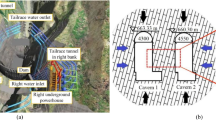Abstract
In this paper an attempt was made to distinguish between some of the general features of the fracture process occurring in various scale levels in different materials. The kinetics of plastic zones near a crack tip and damage accumulation at multiple fractures of metallic specimens are considered. The kinetic diagram of damage accumulation allows an estimate of threshold and transition characteristics of damage evolution. Analysis of seismic activity process in the earth crust has made it possible to suppose that the general features of damage evolution are preserved on the global scale level of fracture process development.
Similar content being viewed by others
References
Bath, M. (1981). Earthquake recurrence of a particular type. Pure and Applied Geophysics 119, 1063–1077.
Benioff, H. (1951). Earthquakes and rock creep, 1: Creep characteristics of rocks and the origin of aftershocks. Bulletin of Seismological Society of America 41, 31–62.
Broek, D. (1980). Elementary Engineering Fracture Mechanics (in Russian). Publishing House Vysshaya Shcola, Moscow, 367 pp.
Botvina, L.R. (1998). Common characteristics of damage accumulation and fracture of solids. In: PROBAMAT-21st Century: Probabilities andMaterials, (Edited by G.N. Frantziskonis), Kluwer Academic Publishers NATO ASI Series 46, 93–107.
Botvina, L.R. and Barenblatt, G.I. (1985). Self-similarity of damage accumulation. Problems of Strength 12, 17–24.
Botvina, L.R., Klevtsov, G.V. and Gladilov, Yu. S. (1982). Zones of plastic deformation under the surface of impact fracture. Problems of Strength 10, 55–59.
Botvina, L.R. and Oparina, I.B. (1993). Regularities of damage processes at different loading conditions. Material Science. The International Journal 4, 13–23.
Botvina, L.R. and Oparina, I.B. (1998). Kinetics of different-scale multiple fracture. Doklady Physics, Journal of the Russian Academy of Sciences 43, 644–647.
Botvina, L.R., Oparina, I.B. and Novikova, O.V. (1997). Analysis of damage accumulation process on various scale levels. Metal Science and Heat Treatment 4, 13–22.
Botvina, L.R., Rotwain, I.M., Keilis-Borok, V.I. and Oparina, I.B. (1995). On the character of the Gutenberg-Richter relation on different stages of damage accumulation and earthquake generation. Reports of Russian Academy of Science 345, 809–812.
Davidson, F.C. Jr. and Scholz, C.H. (1985). Frequency-moment distribution of earthquakes in the Aleutian Arc: a test of the characteristic earthquake model. Bulletin of the Seismological Society of America 75, 1349–1361.
Global Network Data, USGS-NEIS, 1932- 1995 ( World Earthquake Catalog).
Hahn, G.T. and Rosenfield, A.P. (1965). Local yielding and extension of a crack under plane stress. Acta Metallurgica 13, 293–306.
Kachanov, L.M. (1958). On the life-time under creep conditions. Bulletin of the USSR Academy of Sciences, Division of Technical Sciences 8, 26–31.
Karnik, V. and Klima, K. (1993). Magnitude-frequency distribution in the European Mediterranean earthquake regions. Tectonophysics 220, 309–323.
Keilis-Borok, V.I. and Malinovskaya, L.N. (1964). One regularity in the occurrence of strong earthquakes. Journal of Geophysical Research 69, 3019–3025.
Keilis-Borok, V.I. and Kossobokov, V.G. Premonitory activation of earthquake flow: algorithm M8. Physics of the Earth and Planet Interiors 61, 73- 83.
Klevtsov, G.V., Botvina, L.R. and Klevtsova, N.A. (1996). X-Ray diffraction technique for analysing failed components. Iron and Steel Institute of Japan International 36, 215–221.
Magnin, T., Coudreuse., L., and Lardon, J.M. (1985). A quantitative approach to fatigue damage evolution in fcc and bcc stainless steels. Scripta Metallurgica 19, 1487–1490.
Main, I.G., Peacock, S and Meredith, P.G. (1990). Scattering attenuation and the fractal geometry of fracture systems. Pure and Applied Geophysics 133, 283–304.
R 50-54-52-88 (1988). Calculations and tests for strength estimations. Methods of mechanical tests of metals. In: Determination of the depth of plastic zones under fracture surface. VNIINMASH (Institute of The State Standard), Moscow, 1–24.
Rice, J. (1973). Mathematical methods in fracture mechanics. In: Fracture (Edited by Liebowitz), (in Russian), Mir, Moscow 2, 205–335.
Rotwain, I.M., Keilis-Borok, V.I. and Botvina, L.R. (1997). Premonitory transformation of steel fracturing and seismicity. Physics of the Earth and Planetary Interiors 101, 61–71.
Sadovsky, M.A. (1979). On the natural piecewise structure of rocks. Doklady Academii Nauk SSSR 247, 829–840.
Suh, C.M., Yuuki, R. and Kitagawa, H. (1985). Fatigue microcracks in a low carbon steel. Fatigue & Fracture of Engineering Materials & Structures 8, 193–203.
Tchalenko, J.G (1970). Similarities between shear zones of different magnitudes. Bulletin of Geological Society of America 81, 1625–1640.
Tetyueva, T.V., Botvina, L.R. and Krupnin, S.A. (1990). Characteristics of damage of low-alloy steels in corrosionactive hydrogen sulphide-containing media. Physicochemical mechanics of materials (translated from Fiziko-Khimicheskaya Mekhanika Materialov) 2, 27–33.
Varnes, D.J. (1989). Predicting Earthquakes by Analysing Accelerating Precursory Seismic Activity. Pure and Applied Geophysics 130 (4), 661–686.
Voight, B. (1988). A method for prediction of volcanic eruptions. Nature 332, 125–130.
Zhurkov, S.N., Kuksenko, V.S., Petrov, V.A. et al. (1978). Concentration criterion of volume-type fracture in solids. In: Physical Processes in Earthquake Sources, Nauka, Moscow, 101–116.
Author information
Authors and Affiliations
Rights and permissions
About this article
Cite this article
Botvina, L., Oparina, I. Common features of fracture process on various scale levels. International Journal of Fracture 106, 33–45 (2000). https://doi.org/10.1023/A:1007652122314
Issue Date:
DOI: https://doi.org/10.1023/A:1007652122314




